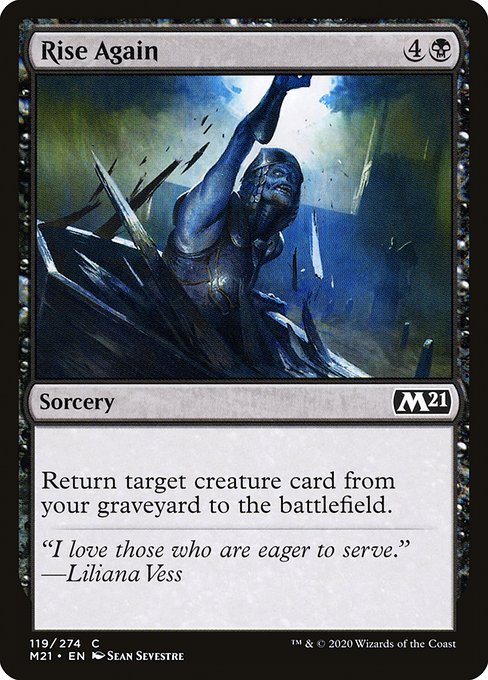
Image courtesy of Scryfall.com
Art and Flavor: How Rise Again Elevates Gameplay Flavor
Magic: The Gathering has long excelled at marrying picture-perfect moments with mechanical clarity, and Rise Again is a compact testament to that balance 🧙♂️. The card lives in Core Set 2021’s shadowy corners as a black sorcery with a five-mana flirtation: {4}{B}. It’s a reminder that in fellowship with Liliana Vess’s world, power often arrives through the quiet invitation of the graveyard. The art by Sean Sevestre presents a mood that nudges players toward a certain playstyle—delaying gratification, savoring the moment when a fallen ally rises to answer the call—while the flavorful flavor text, “I love those who are eager to serve,” reinforces that in black magic, servitude can be a weapon as well as a wound. 🔥💎
Rise Again’s premise is straightforward but deeply thematic: return a target creature card from your graveyard to the battlefield. That single sentence foreshadows a host of strategic possibilities. In the grand tradition of reanimation, this card doesn’t stomp the battlefield with a giant from nowhere; it resurrects a creature you’ve already invested in, often turning a lost late-game resource into a new threat or a crucial blocker. The mechanic sits squarely in black’s wheelhouse—manipulating the graveyard, regaining lost value, and reshaping the board state with a single card. As players, we’re invited to consider not just what we’re bringing back, but when. 🧙♂️⚔️
Return target creature card from your graveyard to the battlefield.
That line isn’t flashy on the surface, but in practice it nudges you toward a distinctive deck-building philosophy. Rise Again rewards graveyard resilience and sequencing: you burn through your resources, you mill or sacrifice, and then you slow-burn to reassemble the board from its ashes. The card’s black identity is clear in its price of admission—five mana to fetch a fallen ally back to life, often late in the game when the opponent’s defenses are thinned. It’s not a one-card win condition; it’s a doorway to midrange-to-control strategies that hinge on persistent value, tempo gains, and a certain quiet rebellion against loss. And in the ritual sense, it echoes Liliana’s world-weary pragmatism—death isn’t the end; it’s an opportunity to bend the battlefield to your will. 🎨🕯️
Flavor-Driven Gameplay: Walking the Graveyard Path
When you parse Rise Again through the lens of flavor, you begin to hear the echo of footsteps in a graveyard, a chorus of long-forgotten voices answering a summons. The creature you choose to return is the heartbeat of your strategy. If you’ve been working with token armies, a single resurrected behemoth can swing momentum in a heartbeat. In creature-heavy shell, you might choose a durable threat to stabilize a stalled board. For graveyard-centric builds, Rise Again becomes a flexible resource that smooths out card draw variance and cushions life-total erosion. The artwork’s somber palette, with its stark contrasts and hints of shadowed figures, reinforces the sense that every return from the grave has a cost—but also a payoff that can tilt the game’s momentum in your favor. 🧙♂️🎲
From a design perspective, the card’s rarity as a common belies its potential to influence games across formats like Modern, Legacy, and Pioneer while staying within affordable bounds. The generic-to-black mana mix makes it a natural fit for midgame curves, where you can stabilize the battlefield and then set up a follow-up play that capitalizes on the returned creature’s immediate impact. In historic and eternal formats, the card’s enduring value lies in its reliability and the timeless thrill of reanimating a fallen ally right as your opponent starts to breathe again. The flavor text’s Liliana line further anchors the card in a larger mythos: even servitude has shades of strategy, and sometimes your best move is the one that seems most willing to return the past to the present. 🔥💎
Practical Deckbuilding How-To
In a typical Rise Again shell, you’ll want a mix of recursion enablers, reliable targets from the graveyard, and enough disruption to keep you from stalling out. Black’s strength in card filtering and removal complements the reanimation plan, allowing you to assemble the right pieces by turn five or six. Because Rise Again is a classic reanimation tool rather than a one-shot finisher, it rewards players who value tempo and resource continuity. Don’t shy away from pairing it with sacrifice outlets or self-munition engines that populate the graveyard; each sacrificed creature becomes a potential revival, and the payoff can be massive when the graveyard churn keeps moving. In multiplayer formats or commander tables, Rise Again can serve as a game-defining pivot when a single revival redraws a board state that looked permanently bleak. ⚔️🧙♂️
Collector’s note: Rise Again’s low price as a common in Core Set 2021 doesn’t reflect its flavor or utility. Foils and non-foil variants alike bring a charming touch to any reanimator or graveyard-themed deck, and the card’s teachable moment—understanding when to resurrect and when to hold—remains a valuable lesson for new players exploring the black mana identity. The art, the flavor text, and the clean, efficient grammar all contribute to a card that’s not just “a spell” but a story beat you can cast and re-cast in your games. 🧙♂️💎
For those who relish long sessions of planning, a comfortable workspace becomes part of the strategy. If you’re mapping out your MTG rituals and desk ergonomics, consider a non-slip gaming pad that keeps your focus on the board rather than on the slip of a mouse. The product behind the link below is a practical companion to marathon matches and casual queues alike, merging form and function in a way that mirrors the synergy between flavor and gameplay that Rise Again embodies. 🔥🎨
Non-slip Gaming Mouse Pad with Polyester Surface
More from our network
- https://blog.digital-vault.xyz/blog/post/visualizing-old-growth-dryads-relationships-in-mtg-network-graphs/
- https://blog.digital-vault.xyz/blog/post/decoding-coalition-skyknights-power-and-toughness-in-mtg/
- https://blog.digital-vault.xyz/blog/post/color-psychology-in-blade-banish-art-for-mtg-fans/
- https://blog.digital-vault.xyz/blog/post/how-to-build-trust-with-transparent-branding/
- https://transparent-paper.shop/blog/post/blue-giant-temperature-reveals-its-life-stage-in-sagittarius/